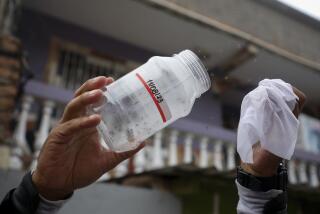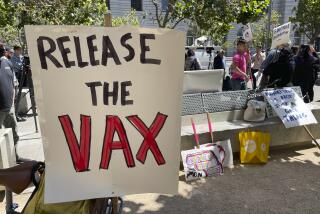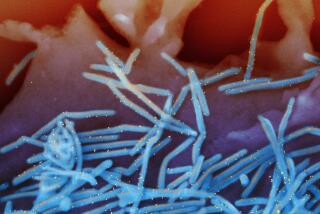After Decades, Developing World Is Still Waiting for a Vital Vaccine
Rotavirus is one of the worldâs biggest killers of children, yet most parents have never heard of it.
Now, more than 30 years after the intestinal bug was identified, pharmaceutical companies are close to winning approval for vaccinations that could save hundreds of thousands of lives every year in the developing world.
Thatâs not where the companies will be selling their drugs: They will be on the market, possibly as early as next year, only in the United States and Latin America, where deaths from rotaviral diarrhea are relatively few. The countries most in need -- including India and nations throughout sub-Saharan Africa -- will have to find a way to pay for a vaccine or wait for financial aid from donor countries and charitable organizations to be able to immunize their children from the highly infectious virus.
But at least they will have something to wait for. An innovative strategy by U.S. public health officials to re-brand the Third World killer as an economic drain on the First World has succeeded in making the development of a rotavirus vaccine cost-effective.
It was a clever answer to a classic problem: finding profit in drugs aimed at diseases that mainly plague the worldâs poorest places.
âTo the drug companies, the market in developing countries is not particularly attractive,â said Ruth Bishop, an Australian microbiologist who led the researchers who identified the virus in 1973. They discovered it in the feces and intestinal tissues of children hospitalized in Australia for severe diarrhea.
Five years ago, the release of a rotavirus immunization in the United States raised hopes that it would eventually reach the places where it was needed most. But the vaccine was yanked from the market after 11 months when one child died of a rare side effect.
The episode raised the safety bar, but it didnât freeze the industryâs efforts to make, and make money from, a vaccine. British pharmaceutical company GlaxoSmithKline and New Jersey-based Merck & Co. pressed on, though they have had to conduct some of the biggest clinical trials in history, involving more than 140,000 children in the United States and Latin America -- groups large enough for rare side effects to be exposed.
Today, the companies are close to tasting the fruits of their labors. GlaxoSmithKline recently got the green light for sales in Mexico and is looking to roll out its product in other Latin American countries over the next few years. Merck is planning to submit its vaccine to the U.S. Food and Drug Administration for approval in fall 2005.
Most children, regardless of where they live, contract rotavirus by age 5. Worldwide, more than 600,000 a year perish from the disease, with the vast majority of deaths in the developing world. In the United States, rotavirus kills a few dozen a year. The treatment is rehydration, which is why the virus can be fatal in poor countries, where clean water and intravenous apparatus are luxuries.
In the mid-1980s, Dr. Albert Kapikian, an infectious disease expert at the National Institutes of Health, created a potential treatment. He knew it would take a company with deep pockets to test a vaccine in clinical trials and bring it to market. Kapikian met with Merck executives, but the company ultimately decided against licensing Kapikianâs vaccine.
The problem wasnât the science. With the cost of developing a new vaccine typically topping $500 million, drug companies traditionally try to recoup the initial investment by introducing the drug in the United States or Europe, where retail pharmaceutical prices are steep. And Merck knew the demand for a rotavirus vaccine was next to nil in the industrialized world.
Without a profitable market, the prospects for a rotavirus vaccine seemed bleak.
âWe needed this to be seen as a global disease,â recalled Dr. Roger Glass, a diarrheal disease expert at the Centers for Disease Control and Prevention.
Glass and his team combed through U.S. hospital records, looking for cases of children admitted with severe diarrhea. They wanted to measure the diseaseâs burden not in deaths but in dollars. And they eventually figured that in hospital visits and days missed from work by parents who had to care for ill children, rotavirus was costing the United States $1 billion a year.
In 1988, just four years after Merck said no, Wyeth licensed the vaccine from the NIH. After a decade of clinical trials, the company received FDA approval to sell the drug in the United States as RotaShield. It won a spot on the government list of recommended childhood vaccinations. In its 11 months on the market, 1.5 million doses, costing $38 apiece, were given to about 650,000 children.
Then, in July 1999, health officials noticed that some youngsters who took the oral treatment suffered a bowel obstruction known as intussusception. One died, and a few dozen required surgery.
Wyeth pulled the vaccine, and the U.S. government withdrew its recommendation.
The intussusception was so uncommon -- federal epidemiologists now estimate the risk at 1 case in 30,000 doses -- that it would have made sense for countries where rotavirus is most deadly to pursue the development of RotaShield. None did. Health officials in Africa and Asia worried about the political fallout of being seen as a dumping ground for a vaccine discarded in the rich world.
âIn the U.S., a vaccine was developed for a market that didnât need it,â said George Armah, a Ghanaian doctor.
But RotaShield was a success in one respect: It proved that a rich nation was willing to pay top dollar to protect its children against a disease that few of them would be likely to contract.
Before the intussusception discovery scuttled RotaShield, Merck was working on a vaccine that it licensed from researchers at the Childrenâs Hospital of Philadelphia. And GlaxoSmithKline in 1997 had struck a deal for the rights to a vaccine invented at Cincinnati Childrenâs Hospital Medical Center.
Merck has opted to stick to the well-worn path of launch- ing in the United States, with hopes of recovering the reported $800 million it has spent to develop what it called Rotateq.
Given the concerns about intussusception, Merck wanted to test its drug only in places where children would have access to top-quality medical care in the event of an adverse reaction, said Penny Heaton, director of biologics and clinical research at Merck Research Laboratories.
The FDAâs standards are so stringent, Heaton added, that approval by the agency would probably speed the vaccineâs acceptance by health authorities in other countries.
GlaxoSmithKline opted to test its drug primarily in Latin America, where rotavirus kills about 15,000 children annually.
Although not as lucrative a market as the United States or Europe, Latin America is viewed in immunization circles as a stable, paying customer, not a charity case. Most Latin American countries fund their own immunization programs instead of relying on handouts from donors, and there is also a viable private-sector market for the well-to-do.
âThe planets just kind of aligned themselves in Latin America,â said Bruce Innis, GlaxoSmithKlineâs vice president for clinical research and development for the region. Innis said the company had spent about $500 million on its vaccine Rotarix.
Neither Merck nor GlaxoSmithKline would disclose target prices for its vaccine. Jean Stephenne, president of GlaxoSmithKline Biologicals, said Rotarix would not be cheap.
Although the company is committed to ensuring that the worldâs poorest countries can buy the vaccine at fair prices, he said, donors and governments will have to step forward with long-term financial commitments.
âWeâve made the vaccine. Weâve done our part,â Stephenne said. âNow itâs time for others to do theirs.â
Several efforts are underway. Companies and government institutes in China, India and Brazil have applied to the NIH to license a vaccine that Kapikian produced. Glass of the CDC is working with Bharat Co., a drug company in India, to âproduce a vaccine at an affordable price,â said Gutla Harshavardham, director of the rotavirus project at Bharat.
And in Minnesota, Biovirx Inc., a company founded in 2002, acquired the license for the discredited RotaShield. The companyâs president, Leonard Ruiz, said that with a low-cost manufacturer, and without all the upfront investment, Biovirx would be able sell the drug far more cheaply than a big pharmaceutical concern could -- and still turn a profit.
The challenge will be finding willing buyers for a vaccine with a sullied reputation. But studies in the United States showed that the risk of the dangerous bowel obstruction disappeared when the first dose of RotaShield was administered in the first three months of life.
Ruiz spends much of his time touting such studies.
âWe have to prove to the world,â he said, âthat RotaShield is a safe and effective vaccine.â







